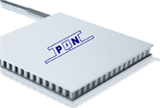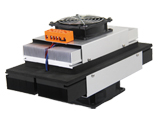Resource > Technical Guidline
Thermoelectric-Module-Working-Principle
author:P&N Tech Time :
2016-08-02 browse:1019
Currently, the most commonly used semiconductor thermoelectric material is Bismuth Telluride alloy, heavily doped to create either P-type or N-type Bismuth Telluride material.
.
As shown above, a P-type and an N-type Bismuth Telluride materials compose a basic PN couple. By heavily doped to create excess electrons in N-type material, and deficiency electrons in P-type material. The extra electrons in the N material and the "holes" (resulting from the deficiency of electrons) in the P material are the carriers which move the electric and heat energy through the thermoelectric material.
When current is loaded to the Thermoelectric Module, it flows back and forth along the PN couples, and the carriers in thermoelectric materials move the heat from one side to the other continually, which generates temperature difference between the two sides of PN couples.
When there is temperature difference between the two sides of Thermoelectric Module, the carriers in thermoelectric materials flows back and forth along the PN couples, and generates electric power.
A practical Thermoelectric Module consists of two or more PN couples that are connected electrically in series, and thermally in parallel.







